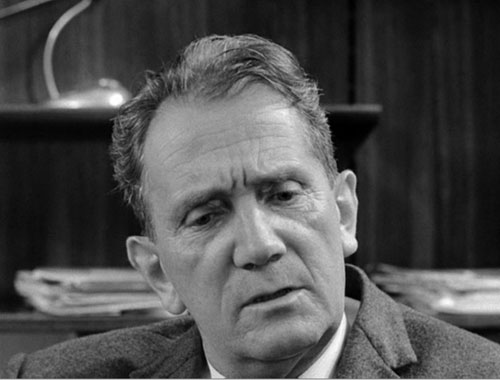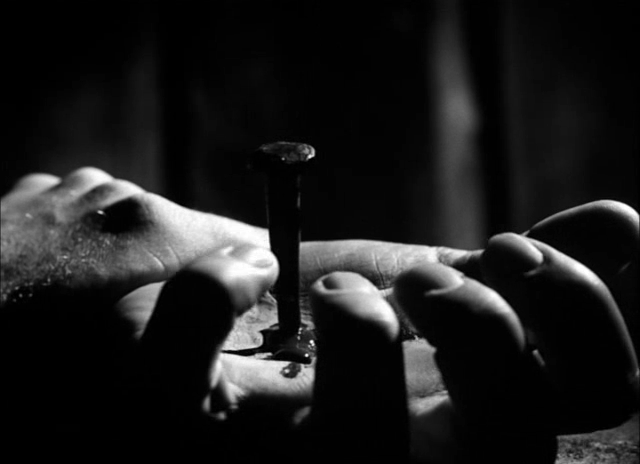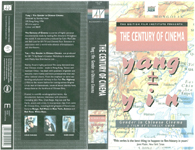From the Chicago Reader (November 22, 1996)..– J.R.
Typically British
•
Directed by Mike Dibb and Stephen Frears
Written by Charles Barr and Frears.
2 X 50 Years of French Cinema
Rating **** Masterpiece
Directed and written by Anne-
Marie Mieville and Jean-Luc Godard
With Godard and Michel Piccoli.
I Am Curious, Film
Rating ** Worth seeing
Directed and written by Stig Bjorkman
With Lena Nyman and Bjorn Granath.
100 Years of Japanese Cinema
Rating * Has redeeming facet
Directed and written by
Nagisa Oshima.
Yang + Yin: Gender in Chinese Cinema
***
Directed and written by Stanley Kwan.
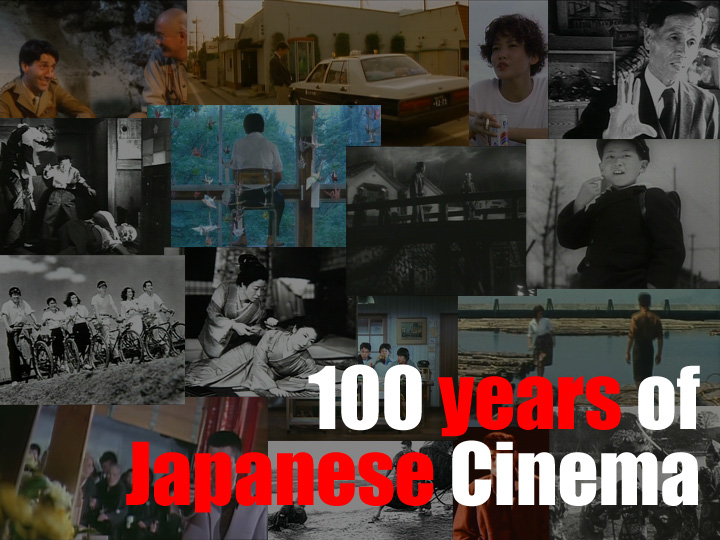
To celebrate the “100th anniversary of cinema,” the British Film Institute has commissioned a series of documentaries about national cinemas. Some of them are still being made, but the first 13 are showing at the Film Center as part of a series that started early this month with the three-part A Personal Journey With Martin Scorsese Through American Movies (excellent) and has continued with documentaries by Sam Neill on New Zealand cinema (witty), by Nelson Pereira dos Santos on Latin American cinema (ambitious but unsuccessful), by Edgar Reitz on German cinema (embarrassing), and by Pawel Lozinski on Polish cinema, realizing an outline by the late Krzysztof Kieslowski (I haven’t seen it). The Neill and Pereira dos Santos entries, showing again on November 30, are in 35-millimeter, and all the others are being screened in projected video; most of them run a little under an hour. (Jean-Pierre Bekolo’s Aristotle’s Plot, an essayistic fiction feature devoted to African cinema that premiered at festivals earlier this year, refused to play by most of the rules established for the series and was dropped from the cycle, though I don’t understand why Pereira dos Santos’s almost equally eccentric Latin America: Cinema of Tears was retained.)
Eight more documentaries in “The Century of Cinema” are still to come at the Film Center, beginning with a pairing of Stephen Frears (British cinema) and Jean-Luc Godard (French) this Friday, followed by Stig Bjorkman (Scandinavian) and Donald Taylor Black (Irish) on November 29, Nagisa Oshima (Japanese) and Jang Sun-woo (Korean) on December 6, and Nikita Mikhalkov and others (Russian) and Stanley Kwan (Chinese language) on December 13.
Judging from the nine entries I’ve seen, this is a highly uneven series. For starters it’s built on the debatable premise that the best way to recount the history of movies is by starting with national cinemas, an approach that fosters insularity, mishandles many major figures who are transnational or multinational (including Akerman, Antonioni, Chaplin, Davies, Dreyer, Godard, Hitchcock, Lang, Murnau, Ruiz, Snow, and Stroheim), and often honors sociology over aesthetics and the typical over the exceptional. Of course most film professors love this approach, because–to paraphrase critic Bill Krohn writing in another context — it allows one institution (academia) to pay homage to another (national bureaucracy) over the body of an artist. So it’s no surprise that an academic and BFI bureaucrat, Colin McCabe, is the principal architect of this package.
Significantly, the late Henri Langlois — the Turkish-born founder of the French Cinematheque who was arguably the key guru of the French New Wave — spent his life railing against state bureaucracies, and his passion fomented a cinephilia that trampled national boundaries with giddy abandon in the 60s and 70s, much as another brand of cinephilia had in the 20s and 30s. But in more conservative eras such as the present foreign filmmakers have to be exhibited like zoo animals in their native habitats to be delivered to an international audience. This is part of the bias that underlies the BFI’s present agenda, which also often hands over the responsibilities of film history to filmmakers rather than to scholars who’ve had more opportunities to educate themselves on the subject. A similar bias can be found in the retooling of the BFI’s principal magazine, Sight and Sound, over the past five years, away from criticism and scholarship and toward the kind of marketplace currency jive that already informs Premiere and Movieline — not to mention a massive downsizing of the institute that generally favors bureaucrats over cinephiles. (As a onetime BFI and Sight and Sound employee — albeit one who left voluntarily 20 years ago — I suppose I could be accused of sour grapes; but my main concern is that serious, knowledgeable film scholars have been replaced by slick, less knowledgeable entrepreneurs — a trend that’s also occurring in film institutions in many other countries, including this one.)
The casualties of this approach include the BFI production that tries to cope with its own national turf — a survey that begins with a provocative allusion to a French New Wave figure. Over the opening titles Stephen Frears proclaims, “The great French film director Francois Truffaut once famously said that there was a certain incompatibility between the terms ‘cinema’ and ‘Britain.’ [Pause.] Well [pause] bollocks to Truffaut.” To Frears’s credit, he wears his upper-class background on his sleeve in the autobiography that follows, and the sheer disdain conveyed in his pauses expresses almost as much as his words do. But most of what follows constitutes a weary confirmation of Truffaut’s bias; Frears is so plainly bored by his subject that he can conclude 50-odd minutes later, “The only truth I have learned is that people when they go to the movies like to see American films.” He can’t even imagine why they shouldn’t — or why this bias may say more about the power of Yankee advertising dollars than about Hollywood aesthetics.
Given such a crass sociological survey of English movies, where the bottom line generally seems like the only game in town, it’s hardly surprising to see Frears reject the whole silent era as inconsequential. He patronizes Michael Powell and Humphrey Jennings (accorded one measly clip each); fails to mention Joseph Losey, Cy Endfield, or Richard Lester (presumably regarding all three as American interlopers); reduces Ken Russell and Mike Leigh to the worst single clips imaginable (and has nothing to say about the TV work of either); limits John Boorman, Bill Douglas, Terry Gilliam, Peter Greenaway, Isaac Julien, and Sally Potter to one fleeting movie poster apiece; and omits virtually the entire English documentary movement (though he includes a disparaging nod to Night Mail), along with the cycle of Hammer horror movies — while paying abject obeisance to the Academy Awards and every crumb they’ve offered British cinema (special points to Chariots of Fire, Gandhi, and Four Weddings and a Funeral). It’s frustrating to imagine what a real critic of English cinema like Raymond Durgnat might have done with what Frears chooses to discuss — not to mention what he leaves out. What we get instead is alienated twaddle about what Frears imagines other people might be interested in — the Janet Maslin school of film commentary.
It may be unfair to saddle Frears with all the inadequacies of this Cook’s tour — even though it’s subtitled “A Personal History of British Cinema,” records some of his memories of movies and of being caned at boarding school, features his gabfests with Hollywood colleagues (critic-screenwriter Gavin Lambert, the late director Alexander Mackendrick, and directors Michael Apted and Alan Parker), and shows him briefly at work on Mary Reilly. Though the press book tries to get one to ignore this, it pairs Frears with a codirector, Mike Dibb, and a cowriter, critic Charles Barr, both of whom are credited first; so maybe Frears — a good director of actors who’s never shown much aptitude for or interest in film aesthetics — was too busy with Mary Reilly to do much more on this than chew the fat with four colleagues and add a few pithy voice-overs. Still, I think I’m fully entitled to conclude, bollocks to Frears.
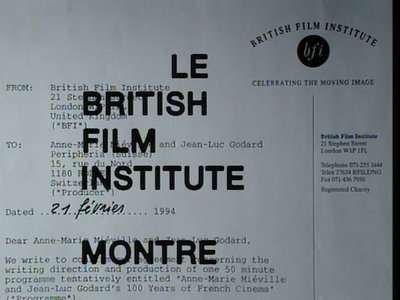
Jean-Luc Godard also begins contentiously in 2 X 50 Years of French Cinema, and also is billed second to director and writer Anne-Marie Mieville, his frequent collaborator. But there the resemblance to Typically British ends. Far from being another potted survey, this is a multifaceted polemic that questions most of the central premises of the “Century of Cinema” series — though not, interestingly enough, the nationalistic orientation (despite the fact that the final image in the video is a photograph of Henri Langlois). Paradoxically it also fulfills the BFI’s commission (Mieville and Godard’s contract pointedly appears under the BFI logo) by offering a comprehensive look at French cinema — though it’s broken up into haunted, lyrical, and mainly obscure fragments; mostly unattributed clips, stills, photographs, and names; and patches of music and dialogue that point to a cinema and a history that are basically forgotten. Just how comprehensive this portrait is may not be apparent on a first viewing; it was only during my third time through the video that I began to see the organizing logic and respond fully to the musical flow and visual poetry. In the French magazine Trafic Jean-Claude Biette aptly employed Manny Farber’s critical categories by calling Godard’s recent film JLG/JLG “white elephant art” (i.e., grandiloquent and self-important) and 2 × 50 Years “termite art” (unpretentious and concerned only with its own boundaries). It’s worth adding that here the obscurity of many of the reference points — which, along with the unpretentiousness, tends to be more evident in the Godard works cosigned by Mieville — is pivotal to the work’s meaning. (A typical obscure reference is to Lucien Coedel, a bit player of the 40s whose daughter makes a guest appearance in one scene.)
In an unidentified European lakeside hotel, actor Michel Piccoli — recently appointed president of France’s First Century of the Cinema Association, based in Lyons at the site of the Lumiere factory — arrives to greet Godard shortly after the Lumiere Institute’s own “century of cinema” celebration in 1995. (This event launched a French centennial-film spin-off, Lumiere & Co., which will play at the Film Center on December 5 and 6 — a fascinating if uneven collection of very short films made by famous filmmakers all over the world, from Peter Greenaway to Abbas Kiarostami to David Lynch to Jacques Rivette to Wim Wenders, all of whom were lent a Lumiere camera to shoot their segments.)
Godard’s skeptical remarks to Piccoli about this celebration circle around three basic points: (1) “Why celebrate cinema? Isn’t it famous enough already?” (2) What’s being celebrated is the commercial exhibition of cinema — the first program of Lumiere films for paying customers was held in 1895 — rather than its invention or production, which is why projectors are highlighted in the publicity rather than cameras. (3) How can we celebrate a history that isn’t even remembered? Godard also observes, “The French cinema is the only one that had critics. In the other countries it became a business right away.” These are the themes that the remainder of the video develops.
At Godard’s invitation, Piccoli spends the night at the hotel — periodically quizzing the staff to see what they know or remember about French cinema, periodically phoning Lyons and reading from books Godard has given him — then leaves the next morning. Through all this, we get not only a panoply of names and film titles, but unidentified and unattributed fragments, many of them certain to be unfamiliar or barely recognized by the audience.
The fragmented style and narrative method of 2 X 50 Years is markedly different from that of his eight-part magnum opus Histoire(s) du cinema (the first half of which has played at the Film Center; the premiere of the complete work is scheduled for Cannes next May), but the philosophical underpinnings are very much the same. Cultural amnesia has been a central theme in his work since the 80s — especially evident in King Lear, but also present in Passion, Nouvelle vague, and Histoire(s) du cinema — and here too it’s central to his poetic form as well as his subject.
Clearly Godard, a filmmaker who started out as a film critic, regards video as a medium for criticism. 2 X 50 Years ends with a moving tribute to French film criticism — using that term broadly enough to include precursors as well as poets, art critics, and filmmaker-theorists — by furnishing us with a honor roll of 15 individuals, from Denis Diderot to Serge Daney, each of whom is accorded a portrait, a page of text, and an offscreen recitation of a brief passage read by Mieville or Godard. A 16th member of this honor roll, Charles Baudelaire, is cited during Piccoli’s haunted vigil in his hotel room, and a 17th, Roger Leenhardt, is heard at some length and briefly seen in what is probably the longest clip in the video. Leenhardt was a film critic and filmmaker of real distinction, though he’s as forgotten today in France as he is unknown in the states; the clip, unidentified like all the others, comes from Godard’s 1965 feature A Married Woman. Leenhardt talks about intelligence and some of its social functions, making observations that apply to all of the writers cited in the closing sequence, including Elie Faure, Andre Malraux, Jean Cocteau, Robert Bresson, Jacques Rivette, and Marguerite Duras.
Stig Bjorkman’s I Am Curious, Film, titled after Vilgot Sjoman’s I Am Curious, Yellow and I Am Curious, Blue, features the lead actress of both, Lena Nyman, as hostess and interlocutor as she moves from Sweden to Denmark, Norway, Iceland, and Finland to speak to a few filmmakers, cinematographers, and actors. (The Swedes, Norwegians, and Danes can understand each other’s languages, so they speak in their native tonuges, but Icelandic director Fridrik Tor Fridriksson and Finnish director Aki Kaurismaki both speak in English. Kaurismaki also inserts a typically wry minifilm of his own, Beer & Cigarettes, presumably modeled after Jim Jarmusch’s series of short films, Coffee and Cigarettes.)
Apart from Godard’s film, this is the only documentary reviewed here that was made by a film critic, which gives it an attentiveness to film history and form not found in most of the other works. Beginning (after the opening sequence from Ingmar Bergman’s Persona) and ending with a consideration of the close-up, this survey can be recommended most of all for its ravishing clips, especially from black-and-white films, and for its willingness to move beyond Scandinavian reference points to make critical points (Pier Paolo Pasolini, Robert Flaherty, Samuel Fuller, Sergio Leone, and Andrei Tarkovsky are all cited).
Because Carl Dreyer is my favorite filmmaker, I was especially interested in seeing how Bjorkman would deal with him. Not surprisingly, he hands over most of this task to Lars von Trier, Dreyer’s most famous self-appointed disciple, and though von Trier’s comments are annoyingly brief and far from adequate, some beautiful clips from Dreyer’s Vampyr and Gertrud are included. Bergman is treated in depth, though he was apparently unwilling or unable to be interviewed; his cinematographer Sven Nykvist and two of his actors, Liv Ullmann and Erland Josephson, are introduced to take up the slack. Other prominent participants include pioneers Astrid Henning-Jensen and Stefan Jarl.
Apart from Akira Kurosawa, Nagisa Oshima is plainly the greatest living Japanese filmmaker, but given that he despises the work of virtually all other Japanese directors, he seems quite unsuited to recount the history of his country’s cinema. In 100 Years of Japanese Cinema he basically turns himself into an academician, and not a very good one at that, giving us a pocket social history of 20th-century Japan in relation to film, in which aesthetic issues play almost no role at all. (At the end he speculates that over the next hundred years Japanese cinema will cease to be Japanese and “will blossom as pure cinema” — something he clearly would like to see happen.)
Kenji Mizoguchi, Yasujiro Ozu, and Kurosawa are accorded only one clip apiece; even more scandalous, Oshima accords himself no less than four clips (from Cruel Story of Youth, The Ceremony, In the Realm of the Senses, and Merry Christmas, Mr. Lawrence) and manages to discuss or mention most of his other features as well. He even foregrounds his self-interest by shifting from third person to first person in his commentary on the 50s through the 80s — an honest approach, but one that tends to play havoc with almost all the other filmmakers; and he’s scarcely convincing when he claims that his third-person commentary is “objective.” The real problem here is that the story of Japanese cinema can hardly be recounted by a single voice, though apart from a quotation or two that’s all Oshima seems willing to offer; for all his intelligence, he takes a backseat to even a drudge like Frears when it comes to conveying a feeling for art.
It’s possible that Oshima’s treatment of contemporary Japanese history is audacious and radical in relation to Japanese norms (he’s withering about state militarism and attentive toward Korean residents in Japan), but how much does it say to the rest of us? The stodgy sociopolitical slant and aesthetic indifference wind up crowding out so much of value in Japanese movies — from Teinosuke Kinugasa’s Page of Madness (accorded only a brief still) to Kon Ichikawa’s An Actor’s Revenge (ignored) to animation and documentaries (crammed into a few fleeting stills), all of which Oshima seems as bored with as Frears is with English cinema — that what remains is hardly sufficient to keep anyone interested.
I don’t mean to suggest that taking a sociopolitical approach to film history is wrong, for it isn’t if it’s done with critical savvy and aesthetic sensitivity. The most slanted “Century of Cinema” documentary in this regard is Stanley Kwan’s 80-minute Yang + Yin: Gender in Chinese Cinema, an examination of films from Hong Kong, Taiwan, and mainland China strictly from the point of view of gender and explicitly from the highly personal and autobiographical vantage point of an openly gay director. It’s worth emphasizing that Kwan neglects many major areas of his subject even within the restricted terrain he’s chosen–most flagrantly woman directors such as mainlander Li Shaohong and Hong Kong filmmaker Clara Law (though he does give extended space to Hong Kong actress Brigitte Lin and Taiwanese critic Peggy Chiao, and he examines at length his own focus as a director of films about women), not to mention figures as important as Tian Zhuangzhuang, Zhang Yimou, Yim Ho, and Wayne Wang. (The fact that he omits the silent Chinese cinema is surely more defensible, if only because his masterpiece Actress, coscripted by Chiao, has already dealt beautifully and brilliantly with that subject.)
But this is still the most exciting and comprehensive survey of Chinese cinema that I know of. Dividing his survey into half a dozen chapters dealing with such topics as “Absence of the Father,” “Feminine and Masculine, Face and Body,” father figures, elder-brother figures who become father surrogates, and transvestites and transsexuals, Kwan may give short shrift to mother figures–apart from his own mother, whose very moving comments conclude the film. But he nevertheless succeeds at describing the contours of a wide-ranging film history and the changes in culture that inform that history (a task Oshima only halfheartedly makes a few stabs at).
Along the way Kwan introduces a fascinating array of relatively unknown figures (I’m especially intrigued by Maxu Weibang, a “uniquely perverse” horror specialist who worked in the Shanghai studios in the 30s) and also provides absorbing commentary by and about, among others, Hong Kong action director Chang Cheh and his disciple John Woo; Hong Kong directors Wong Kar-wai and Allen Fong; Taiwanese directors Hou Hsiao-hsien, Edward Yang, Ang Lee, and Tsai Ming-liang (most of them speaking about their fathers or children and how these relationships inflect their films); older mainland directors such as Xie Jin; and actor Leslie Cheung (critiquing some of his own pictures). Kwan interviews heterosexual directors Chen Kaige, Tsui Hark, and Zhang Yuan (a maverick mainland independent) about their sexual attitudes — and charges Chen’s Farewell My Concubine with homophobia, particularly in relation to the Lilian Lee novel it’s based on — and in the process bears intelligent witness not only to the changes in sexual sensibility and family values taking place across the Chinese-speaking world, but also to the range and vitality of the recent filmmaking that reflects these changes. In short, Yang + Yin is far from complete in recounting the history of Chinese film, but it will do just fine until a more comprehensive survey comes along.

